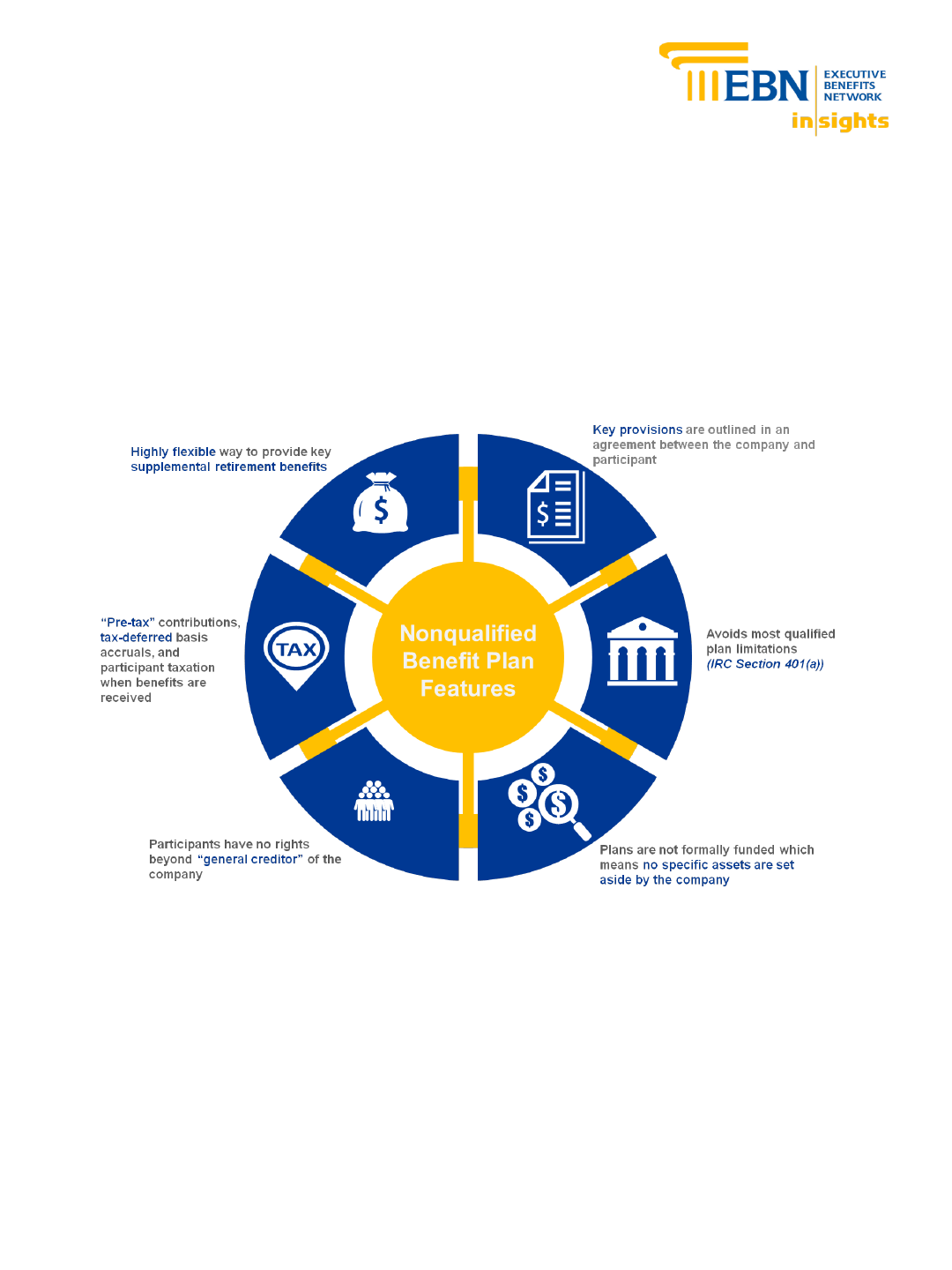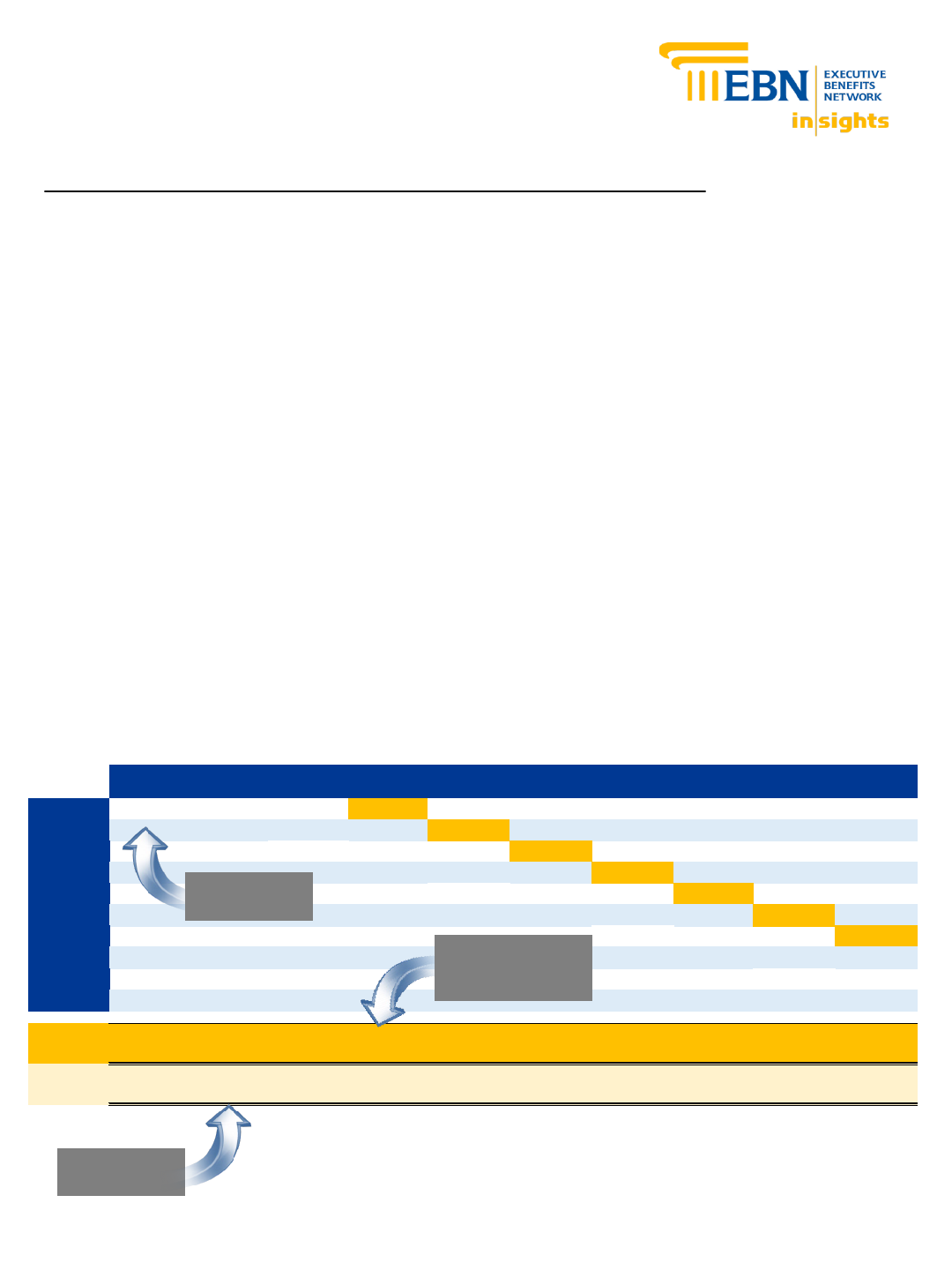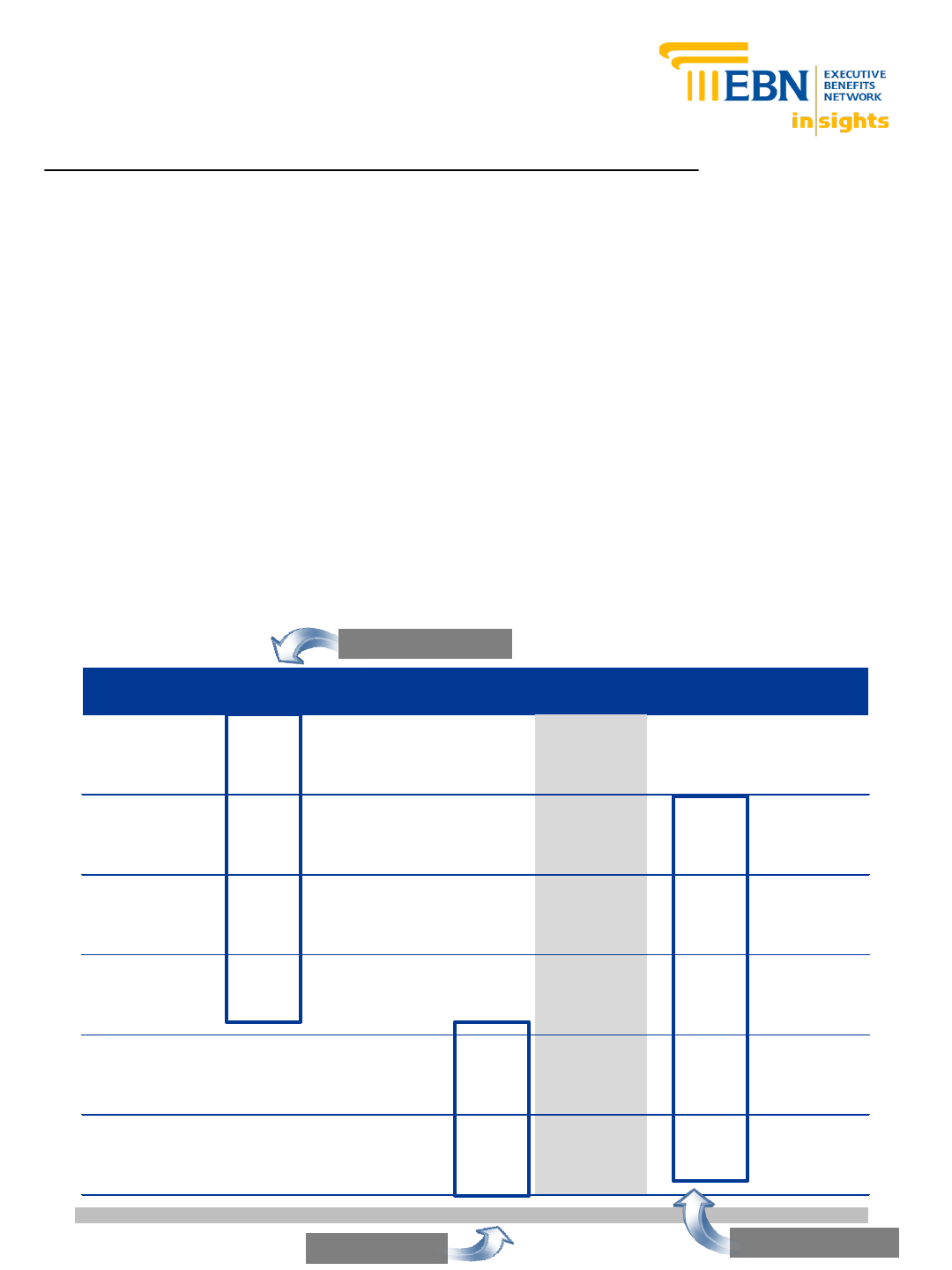
Prepared by:
August 2019
Short-Term & Long-Term
Incentive Plans
Executive Benefits Network
833 East Michigan Street | Suite 1480
Milwaukee, WI 53202
Phone 414.431.3999
Fax 414.431.9689
ebn-design.com

The “Why” for Nonqualified Benefit Plans
Nonqualified benefit plans are implemented to recruit, retain and reward key employees. Properly
implemented plans motivate and reward employees to work towards common company goals while retaining
employees with a long-term outlook. These plans enable companies to provide appropriate retirement
benefits with a more targeted and efficient use of benefit dollars. There are a few different plans to consider
when looking at a nonqualified retention plan. These include: Short-Term Incentive Plan (STIP), Long-Term
Incentive Plan (LTIP), Supplemental Executive Retirement Plan (SERP), Voluntary Deferral Plan and a Split
Dollar Plan. Specifically, we will be focusing on Short-Term and Long-Term Incentive Plans providing an
overview of each plan, advantages and a sample design structure.
Short-Term and Long-Term Incentive Plans
The best way for these plans to recruit, retain and reward your employees is implementing both an STIP and
LTIP. The two plans complement each other and can be very effective if designed properly. STIPs should be
used to motivate key employees to execute the company goal’s and make good operating decisions to
maximize performance over the course of the year. LTIPs are developed to achieve long-term growth and
increase the value of the organization over a long period of time. These plans are not governed by the
Employee Retirement Income Security Act of 1974 (ERISA). They are simply bonus plans for key employees.
2

Short-Term Incentive Plan
The objective of an STIP is to reward key employees for their individual
contribution for achieving the company’s short-term business strategies and
goals set by the compensation committee to increase the company’s
profitability. This plan is similar to a cash incentive plan. STIP metrics are
determined by a compensation committee and can be measured both
financially, such as revenue growth or maximizing profit or non-financially,
with goals that align with the company strategy, such as meeting safety or
quality assurance hurdles or the development of a new product.
Employer Benefits of STIPs:
Provides greatest “pay for performance” flexibility
Each contribution has its own vesting schedule (i.e. 5 year rolling vesting)
Plan costs are offset indirectly through increasing profitability
Employee Benefits of STIPs:
Participant is rewarded based on a percentage of base pay (i.e. 5% to 25%)
being contributed on a pre-tax basis
Contributions grow on a tax-deferred basis tied to a fixed or variable rate
index (selected by the employer)
Distributions at the end of each vesting cycle provide employee a
meaningful payout while employed making the benefit more relevant than
a retirement-based benefit
3
Objectives of Incentive Plans
Offer a reward for exceeding set goals
Provide a market-competitive cash compensation opportunity
Assist in recruiting and retaining key employees critical to the company’s
success
Support and reward the achievement of the company and individual results
Build a strong, performance-based culture across the company
A Short-Term Incentive
Plan rewards key
employees for their
individual contribution
for achieving the
company's short-term
business strategies
and goals.

Sample Case Study: Short-Term Incentive Plan for Future Leaders
Scenario:
CEO and Board have identified several key individuals to be future leaders of the bank
Bank is in a competitive urban marketplace, where retention is a challenge and recruiting key talent is
equally as hard
Company pays competitive salary and cash bonuses, but has no long-term retention plans in place for
this group
Traditional deferred compensation programs have little power for this group due to the number of
years they have to wait to receive the funds
4
End of
Plan Year
1 2 3 4 5 6 7 8 9 10
1 $10,000 $10,450 $10,920 $11,412 $0 $0 $0 $0 $0 $0
2 0 $10,300 $10,764 $11,248 $11,754 $0 $0 $0 $0 $0
3 0 $0 $10,609 $11,086 $11,585 $12,107 $0 $0 $0 $0
4 0 0 0 $10,927 $11,419 $11,933 $12,470 $0 $0 $0
5 0 0 0 0 $11,255 $11,762 $12,291 $12,844 $0 $0
6 0 0 0 0 0 $11,593 $12,114 $12,660 $13,229 $0
7 0 0 0 0 0 0 $11,941 $12,478 $13,039 $13,626
8 0 0 0 0 0 0 0 $12,299 $12,852 $13,431
9 0 0 0 0 0 0 0 0 $12,668 $13,238
10 0 0 0 0 0 0 0 0 0 $13,048
$0 $0 $0 $11,412 $11,754 $12,107 $12,470 $12,844 $13,229 $13,626
$10,000 $20,750 $32,293 $33,262 $34,259 $35,287 $36,346 $37,436 $38,559 $39,716
Payout
Amount
Unvested
Balance
Benefit paid out first
of the year after
4-year vesting
Serves as a
Golden Handcuff
Employer
Contribution
Assumptions:
Annual Employer Contribution:
$10,000 (10% of pay)
Cost of Living Adjustment:
3%
Annual Interest Crediting Rate:
4.5%
Vesting Schedule:
4-year rolling vesting
Benefit Payout:
Lump Sum

Long-Term Incentive Plan
Similar to an STIP, the purpose of an LTIP is to reward and retain key
employees providing to the company's achievement in their goals and
objectives. LTIPs are focused on the company’s long-term goals and
accomplishments. Typically, LTIPs are a mix of equity (ie. stock options,
performance shares, etc.) and a cash component. This plan allows the key
employee help achieve the performance goals of the company in order to earn
more for themselves in either compensation or stock in the future.
LTIP’s are beneficial for those key employees who are loyal to the company in
hopes that they will stay for years. The drawback of an LTIP is that if the
benefit is so far out, it appears to be unreachable to that key employee. They
may find another opportunity that has a more immediate compensation
payout.
Employer Benefits of LTIPs:
Contributions are pre-tax and all account values grow on a tax-deferred
basis
Vesting reduces costs on short-term participation
Plan costs are offset indirectly through increased profitability
Provides greatest “pay for performance” flexibility
Employer can determine an annual interest crediting rate to be added to
the account values
Employee Benefits of LTIPs:
Employer provides personal wealth accumulation
Executives are financially rewarded for contributing to company’s success
Provided with a meaningful supplemental retirement benefit
5
Long-Term Incentive
Plans allow key
employees help
achieve performance
goals of the company
in order earn more
for themselves.

10%
Annual Projected Vested Unvested
Employer
Benefit Account Account Account
Contribution
Accrual Balance Balance Balance
1 $100,000
$10,000 ($10,000) $0 $10,000 $0 $10,000
2 103,000
10,300 (10,707) 0
20,707 0 20,707
3
106,090 10,609 (11,453) 0 32,160 0 32,160
4 109,273 10,927 (12,238) 0 44,398 0 44,398
5 112,551
11,255 (13,064) 0 57,462 0
57,462
6 115,927
11,593 (13,934) 0 71,395 7,140 64,256
7 119,405 11,941 (14,849) 0 86,245 17,249 68,996
8 122,987
12,299 (15,812) 0 102,057 30,617 71,440
9 126,677 12,668 (16,826)
0 118,883 47,553 71,330
10 130,477 13,048 (17,891)
0 136,774 68,387 68,387
11 134,392 13,439 (19,012) 0 155,785 93,471
62,314
12 138,423 13,842 (20,189) 0 175,975 123,182 52,792
13 142,576 14,258 (21,427) 0 197,402 157,921 39,480
14 146,853 14,685 (22,728)
0 220,130 198,117 22,013
15 151,259 15,126 (24,094) 0
244,224 244,224 0
16 155,797 15,580 (25,530) 0
269,754 269,754 0
17 160,471 16,047 (27,037) 0 296,791 296,791 0
18 165,285 16,528 (28,620) 0 325,411 325,411 0
19 170,243 17,024 (30,282) 0 355,693 355,693 0
20 175,351 0 (13,690) (39,613) 329,770 329,770 0
21 180,611 0 (12,487) (43,215) 299,043 299,043 0
22 186,029 0 (11,236) (43,215) 267,064 267,064 0
23 191,610 0
(9,933) (43,215) 233,782 233,782 0
24 197,359 0 (8,577) (43,215) 199,144 199,144 0
25 203,279 0 (7,166) (43,215) 163,095 163,095 0
26 209,378 0 (5,697) (43,215)
125,577 125,577 0
27 215,659 0 (4,168) (43,215) 86,531 86,531 0
28 222,129 0 (2,578) (43,215) 45,894 45,894 0
29 228,793 0 (922) (43,215) 3,601 3,601 0
30 235,657 0 (0) (3,601) 0 0 0
Projected
Salary
Benefit
Payment
Sample Case Study: Long-Term Incentive Plan for Future Leaders
Scenario:
CEO and Board have identified several key individuals to be future leaders of the bank
Company is in a competitive urban marketplace, where retention is a challenge and recruiting key
talent is equally as hard
Company pays competitive salary and cash bonuses, but has no long-term retention plans in place for
this group
Company wants to provide their future leaders an extra retirement benefit
6
Assumptions:
Annual Employer Contribution:
$10,000 (10% of pay)
Cost of Living Adjustment:
3%
Annual Interest Crediting Rate:
4%
Vesting Schedule:
0% Years 1-5; 10% per year after
Benefit Payout:
Paid out in 10 equal annual installments
Employee Benefit
Employer Contribution
.
Retention Component
$251,169 ($432,147) ($432,147)

Conclusion
In order to implement one of these plans, the company has to determine its overall goals and objectives. This
will help determine if both an STIP and LTIP would work for their company, or if only one would be necessary.
In order to determine which may be best, consider the following:
What are competitors offering?
What are the ages and generations of your key employees?
What attracts your employees to the company?
What are your key employees future goals with the company?
Do your key employees appear loyal and satisfied with the company?
As mentioned, STIPs and LTIPs compliment one another by providing a ‘reachable’ incentive coupled with a
longer term incentive.
About Executive Benefits Network (EBN):
As the leading industry advisor, EBN specializes in the customized design, administration, and informal financing
of Nonqualified Executive Compensation and Benefit Plans (Deferred Compensation Plans), as well as the
procurement of Bank Owned Life Insurance (BOLI) programs to attract, retain, and reward key executive
talent. We emphasize the importance of education and build long-lasting relationships with clients in all 50
states, and we have access to the highest rated insurance companies in the nation. Lastly, we believe that no
two companies are alike in their needs; therefore, customization of executive benefit and compensation plans is
paramount to a successful program.
7

ABOUT THE AUTHORS
David is the Co-Founder of Executive Benefits Network and a 33-year veteran of the financial services industry.
David is a frequent speaker across the banking industry as an expert in the area of Nonqualified executive
benefit plans and Bank Owned Life Insurance programs. David is the Chairman of The American College
Foundation, Director of the Association Advanced Life Underwriting (AALU), , Trustee of the Village of River Hills,
President of the Milwaukee Country Club and Past-President of the Milwaukee Winter Club Youth Hockey
Organization. He is a member of the Indiana Bankers Association, Wisconsin Bankers Association, Bank Holding
Company Association, the Society of Financial Service Professionals and the MDRT Association’s Court of the
Table.
Pat is a Co-Owner and Managing Director of Executive Benefits Network and a 19-year veteran of the financial
services industry. Prior to entering the financial services industry, Pat worked as a senior accountant in audit for
KPMG in the bank service area and as an attorney for Michael Best & Friedrich LLP where he concentrated on
general corporate and securities law. Pat’s career focus is in the BOLI/COLI marketplace, as well designing
creative strategies for executive compensation planning, business succession planning and estate planning. Pat
is a shareholder and Director of a bank in Iowa and is an active member in the State Bar of Wisconsin. He is a
frequent speaker in industry meetings and seminars. He is a member of the Community Bankers of Iowa, Iowa
Bankers Association and Wisconsin Bankers Association.
R. David Fritz Jr., CLU
®
Managing Partner
dfritz@ebn-design.com
Office: (414) 431-9688
Patrick J. Marget, JD, CPA, CFP
®
, CLU
®
Managing Director
pmarget@ebn-design.com
Office: (414) 431-9681
8
